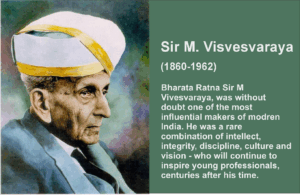
Construction
Sir Mokshagundam Visvesvaraya KCIE, FASc (Moːkśguṇam Viśveśvarayya; 15 September 1861 – 12/14 April 1962) also referred to by his initials, MV, was an Indian civil engineer, administrator, and statesman, who served as the 19th Dewan of Mysore from 1912 to 1918
Visvesvaraya is regarded in India as one of the foremost civil engineers whose birthday, 15 September, is celebrated every year as Engineer’s Day in India, Sri Lanka, and Tanzania. He is also often regarded as “the maker of modern Mysore” According to Prajavani, a Kannada language newspaper, he is also the most popular figure in the southern Indian state of Karnataka.
Visvesvaraya worked as a civil engineer for the government of British India and later as Prime Minister of the Kingdom of Mysore. For his services to British India, he was appointed CIE and later knighted KCIE For his services to the Kingdom of Mysore and the Republic of India, he was awarded the Bharata Ratna by Government of India in 1955
Early life
Visvesvaraya was born on 15 September 1861 at Muddenahalli, Kingdom of Mysore (in present-day Chikkaballapura district, Karnataka) into a Telugu speaking family of Mokshagundam Srinivasa Shastry and Venkatalakshmi. His ancestors hail from Mokshagundam, a village in present-day Prakasam district of Andhra Pradesh, and had migrated to the kingdom years prior to Visvesvaraya’s birth.
Visvesvaraya received his primary education in Bangalore and earned a Bachelor of Science (BSc) degree from the University of Madras. He later studied at the College of Engineering, Pune (then College of Science at the University of Bombay) and graduated as an engineer, receiving Diploma in Civil Engineering (DCE) It was here that he helped found and become a member of the Deccan Club and was its first secretary; he was well-acquainted with the progressives in Pune, including Sir R. G. Bhandarkar, Gopal Krishna Gokhale, and Justice Mahadev Govind Ranade, who were instrumental in starting the club and were its members
Career
Visvesvaraya began his career by working for the Government of British India, working in Bombay Presidency and other British-held colonies in the Middle East. He later worked for Hyderabad State. After retirement, he began his administrative and statesmanship career and continued his engineering career in the Kingdom of Mysore.
Engineering career
Visvesvaraya became an assistant engineer in 1885 at the Public Works Department, Bombay, in Bombay Presidency.
In 1899, Visvesvaraya was invited to join the Indian Irrigation Commission where he implemented an intricate system of irrigation in the Deccan Plateau and designed and patented a system of automatic weir water floodgates that were first installed in 1903 at Khadakvasla Dam near Pune. These gates raised the storage level in the reservoir to the highest level likely to be attained without causing any damage to the dam. Based on the success of these gates, the same system was installed at Tigra Dam in Gwalior and later at the KRS Dam at Mysore, Karnataka. He later became the chief engineer of the Laxmi Talav Dam near Kolhapur.
In around 1906/1907, the Government of British India sent Visvesvaraya to the British Colony of Aden (present-day Yemen), to study water supply and drainage systems. The project prepared by him was successfully implemented in Aden.
After opting for voluntary retirement in 1908, Visvesvaraya took a foreign tour to study industrialised nations. Then, for a short period, he worked for Nizam Osman Ali Khan. He was one of the chief engineers of the flood protection system for the city of Hyderabad who suggested flood relief measures for the city, which was under constant threat by the Musi river. He achieved celebrity status when he designed a flood protection system for the city. He was instrumental in developing a system to protect Visakhapatnam port from sea erosion. This dam created the biggest reservoir in Asia at the time of its construction.
In November 1909, at the invitation of Dewan V.P. Madhava Rao, Visvesvaraya joined as a chief engineer of Mysore State. He was the Chief Engineer of the KRS Dam at Mysore. He was also later the chairman of the board of engineers for the Tungabhadra Dam in Hospet, Karnataka.
Premiership
In 1912, Visvesvaraya was appointed Dewan of Mysore by Maharaja Krishnaraja Wadiyar IV. He served for nearly seven years until 1918. With support from the maharaja, Visvesvaraya contributed to the general development of the Kingdom of Mysore.
During his premiership as Dewan, Visvesvaraya was responsible for the founding of factories and institutions funded for by the maharaja, including Mysore Soap Factory, Parasitoid Laboratory, Mysore Iron & Steel Works in Bhadravathi, Bangalore Polytechnic (now Sri Jayachamarajendra Polytechnic Bangalore), Bangalore Agricultural University, State Bank of Mysore, Century Club, Mysore Chamber of Commerce (now Federation of Karnataka Chambers of Commerce & Industry), Mysore Apex Chamber of Commerce (now Apex Chamber of Karnataka), and numerous other industrial places.The Bangalore Press was also established during his tenure as Dewan. He was also instrumental in the founding of Government Engineering College (now University Visvesvaraya College of Engineering) at Bangalore in 1917, one of the first engineering institutes in India. He commissioned several new railway lines in Mysore Railways (now part of Southwestern Indian Railways).
Visvesvaraya encouraged private investment in industry during his tenure as Dewan. He was instrumental in charting out a plan for road construction between Tirumala and Tirupati
Visvesvaraya gave his technical advice for the location of Mokama Bridge over the Ganga in Bihar. At the time, he was over 90 years old
Career timeline
Assistant Engineer in Bombay, 1885; served in Nasik, Khandesh (mainly in Dhule) and Pune
Services lent to Municipality of Sukkur, Sind, 1894; designed and carried out waterworks for the municipality
Executive Engineer, Surat, 1896
Assistant Superintending Engineer, Pune, 1897–1899; visited China and Japan, 1898
Executive Engineer for Irrigation, Pune, 1899
Sanitary Engineer, Bombay, and member, Sanitary Board, 1901; gave evidence before Indian Irrigation Commission
Designed and constructed automatic gates patented by him at Lake Fife Storage Reservoir; introduced a new system of irrigation known as “Block System”, 1903; represented the Bombay Government at Simla Irrigation Commission, 1904; on special duty, 1905
Superintending Engineer, 1907; visited Egypt, Canada, United States, and Russia, 1908
Consulting Engineer to Hyderabad/Nizam State supervised and carried out engineering works on Musi river; Hyderabad floods of 1909
Retired from British Service, 1909
Chief Engineer and Secretary to Government of Mysore, 1909
Dewan of Mysore, Public Works Department and Railway, 1913
Board of Directors of Tata Steel, 1927–1955
